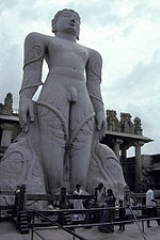
Jainism
Overview
Jainism is an Indian religion that prescribes a path of non-violence
towards all living beings
. Its philosophy and practice emphasize the necessity of self-effort to move the soul
towards divine consciousness and liberation
. Any soul that has conquered its own inner enemies and achieved the state of supreme being is called a jina ("conqueror" or "victor"). The ultimate status of these perfect souls is called siddha
. Jainism is also referred to as shramana
dharma (self-reliant) or the "path of the nigantha
s" (those without attachments or aversions) by ancient texts.
Jain doctrine teaches that Jainism has always existed and will always exist, although historians date the foundation of the organized or present form of Jainism to sometime between the 9th and the 6th century BC.
It has been hypothesized that, like several traditions in Hinduism
, Jainism may have had its roots in the Indus Valley Civilization
, reflecting native spirituality prior to the Indo-Aryan migration into India
.
Ahimsa in Jainism
Ahiṃsā in Jainism is a fundamental principle forming the cornerstone of its ethics and doctrine. The term "ahimsa" means “non-violence”, “non-injury” or absence of desire to harm any life forms. Vegetarianism and other non-violent practices and rituals of Jains flow from the principle of Ahiṃsā...
towards all living beings
Jiva
In Hinduism and Jainism, a jiva is a living being, or more specifically, the immortal essence of a living organism which survives physical death. It has a very similar usage to atma, but whereas atma refers to "the cosmic self", jiva is used to denote an individual 'living entity' or 'living...
. Its philosophy and practice emphasize the necessity of self-effort to move the soul
Jiva
In Hinduism and Jainism, a jiva is a living being, or more specifically, the immortal essence of a living organism which survives physical death. It has a very similar usage to atma, but whereas atma refers to "the cosmic self", jiva is used to denote an individual 'living entity' or 'living...
towards divine consciousness and liberation
Moksa (Jainism)
' or Mokkha means liberation, salvation or emancipation of soul. It is a blissful state of existence of a soul, completely free from the karmic bondage, free from samsara, the cycle of birth and death. A liberated soul is said to have attained its true and pristine nature of infinite bliss,...
. Any soul that has conquered its own inner enemies and achieved the state of supreme being is called a jina ("conqueror" or "victor"). The ultimate status of these perfect souls is called siddha
Siddha
A Siddha सिद्ध in Sanskrit means "one who is accomplished" and refers to perfected masters who, according to Hindu belief, have transcended the ahamkara , have subdued their minds to be subservient to their Awareness, and have transformed their bodies into a different kind of body dominated by...
. Jainism is also referred to as shramana
Shramana
A shramana is a wandering monk in certain ascetic traditions of ancient India including Jainism, Buddhism, and Ājīvikism. Famous śramaṇas include Mahavira and Gautama Buddha....
dharma (self-reliant) or the "path of the nigantha
Nirgrantha
A Nirgrantha is a term that specifically refers to Jains in religious and philosophical works from the Indian religions. Mahavira , the most recent Jain tirthankara and a contemporary of Gautama Buddha, is referred to as the Nigaṇṭha Nātaputta in the Pāli Tipiṭaka.The Jain Agamas also contain...
s" (those without attachments or aversions) by ancient texts.
Jain doctrine teaches that Jainism has always existed and will always exist, although historians date the foundation of the organized or present form of Jainism to sometime between the 9th and the 6th century BC.
It has been hypothesized that, like several traditions in Hinduism
Hinduism
Hinduism is the predominant and indigenous religious tradition of the Indian Subcontinent. Hinduism is known to its followers as , amongst many other expressions...
, Jainism may have had its roots in the Indus Valley Civilization
Indus Valley Civilization
The Indus Valley Civilization was a Bronze Age civilization that was located in the northwestern region of the Indian subcontinent, consisting of what is now mainly modern-day Pakistan and northwest India...
, reflecting native spirituality prior to the Indo-Aryan migration into India
Indo-Aryan migration
Models of the Indo-Aryan migration discuss scenarios of prehistoric migrations of the proto-Indo-Aryans to their historically attested areas of settlement in the northwest of the Indian subcontinent...
.
Unanswered Questions

